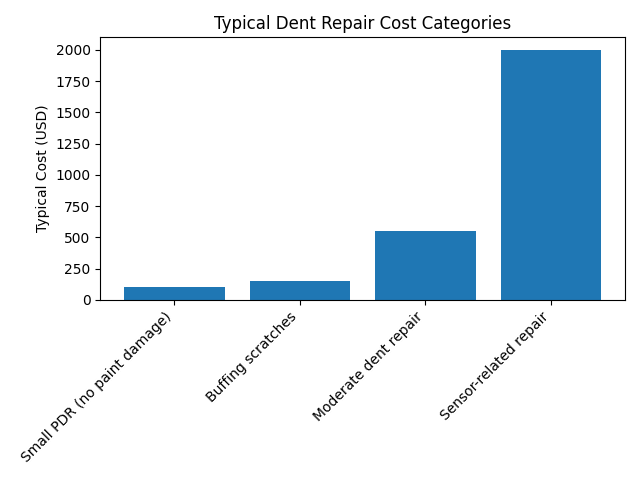Dent Repair in Oxnard: Should You Fix It or Leave It?
It only takes a moment for a stray shopping cart or an inattentive driver on Oxnard Boulevard or the 101 Freeway to leave a dent in your vehicle. The question many drivers ask is, “Is it worth fixing a small dent, or should I just live with it?” Deciding whether to repair or ignore a dent depends on several factors: the severity of the damage, whether paint is broken, potential for corrosion and the vehicle’s resale value. This article walks you through those considerations so you can make an informed choice.
1. Evaluate the Damage
Start by assessing the size and depth of the dent and whether the paint has been compromised. Run the fingernail test: lightly drag your nail across the scratch. Automotive experts note that most light scratches sit in the top clearcoat and can be polished out, but if your nail catches, the damage likely penetrates deeper and requires professional repair (motortrend.com). Also check for cracks in the paint or exposed metal—these are entry points for moisture and rust.
Paintless dent repair (PDR)
If the paint isn’t broken and the dent is small—common on doors and fenders—Paintless dent repair (PDR) may be an option. According to Consumer Reports, paintless dent repair usually costs $50 to $150 per dent and preserves your factory finish. DIY kits sell for $20–$30, but professional PDR technicians have specialized tools and experience to avoid stretching the metal. Minor scratches and chips can also be buffed out by a body shop for $100 to $200. (consumerreports.org)
2. Risks of Leaving a Dent Unrepaired
Corrosion and rust
When paint and primer are cracked, bare steel is exposed to moisture and oxygen. Materials scientists explain that rust forms when iron reacts with oxygen and water (reliance-foundry.com). Even a small chip can allow corrosion to spread under the surrounding paint. Over time this weakens the metal, leading to bubbling paint, larger holes and more costly bodywork.
Hidden safety and sensor issues
Modern vehicles hide radar, camera and ultrasonic sensors behind bumper covers and body panels. AAA warns that even a minor fender bender can knock these advanced driver assistance system (ADAS) sensors out of alignment, and failing to recalibrate them may cause features like automatic emergency braking or blind‑spot monitoring to malfunction. The organization notes that minor collisions involving ADAS equipment can add $900 to $3,000 in additional repair costs. If a dent occurs near a sensor (for example, in a bumper corner), professional inspection and calibration are essential.
Resale value
Even if you repair the damage, a record of the accident will appear on vehicle history reports. Kelley Blue Book points out that any reported accident—big or small—reduces a car’s market value. A poorly repaired dent can also diminish value, and potential buyers may assume other maintenance has been neglected. On the other hand, fixing small cosmetic damage can make your vehicle more appealing, especially in competitive used‑car markets like Ventura County.
3. Weigh the Costs and Benefits
Before making a decision, compare the cost of repairs against the potential downside of leaving the dent.
Cost to repair small dents: As noted, PDR for small dings typically runs $50–$150 per dent. Buffing out light scratches costs $100–$200 (consumerreports.org).
Moderate damage: Dents that crack paint or deform body lines require traditional bodywork, including sanding, filler and repainting. Costs vary widely but can range from a few hundred to over a thousand dollars depending on the panel and paint matching. Insurance may cover the repair if the dent resulted from a collision.
Sensor‑related repairs: When ADAS sensors are damaged or misaligned, AAA reports that repair bills can jump by thousands of dollars. Front radar sensor replacement ranges $900–$1,300 and rear sensors $850–$2,050. These expenses are in addition to standard bodywork.
To visualize how repair costs vary by severity, the chart below compares typical dent repair categories. Notice how costs rise sharply when sensors are involved:
4. Prevention and Mitigation Tips
While dents are sometimes inevitable, good habits reduce the chances of needing repairs:
Park defensively. Choose end spots or spaces away from crowded areas in shopping centers along the Oxnard Plaza and Ventura malls. More space around your car means fewer door dings.
Maintain safe following distances. Avoid tailgating on Highway 101 to reduce the risk of rear‑ending and bumper damage.
Use protective accessories. Door edge guards, bumper protectors and clear film can shield vulnerable areas from scratches and minor impacts.
Address paint chips promptly. Touch up small chips with factory‑matched paint to seal exposed metal and prevent rust.
Stay current on insurance. Comprehensive coverage can help pay for dent repair and ADAS calibration. Review your policy to ensure you’re covered for cosmetic damage.
5. Dent Repair at Prestige Bodyworks
If you decide to repair a dent, choosing an experienced shop matters. Prestige Bodyworks in Oxnard offers:
Paintless dent repair using specialized tools to massage out small dents from the inside without harming your factory paint. This method preserves your vehicle’s value and avoids repainting.
Traditional bodywork for larger dents, using OEM parts and manufacturer‑approved techniques to maintain structural integrity. We match paint precisely to restore your car’s appearance.
Insurance assistance with USAA and State Farm direct repair programs to streamline claims. We work with all carriers and can help you decide whether to file a claim or pay out of pocket.
Conclusion
Deciding whether to fix or leave a dent isn’t just about appearance. Unrepaired dents can expose metal to rust, knock advanced safety sensors out of alignment and reduce your car’s resale value (reliance-foundry.com). For minor dings with intact paint, affordable paintless dent repair is often worth the investmentconsumerreports.org. For deeper or sensor‑related damage, professional repair and calibration are essential to maintain safety and value. Ultimately, taking care of dents promptly protects your vehicle and your wallet.


